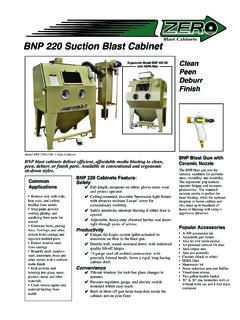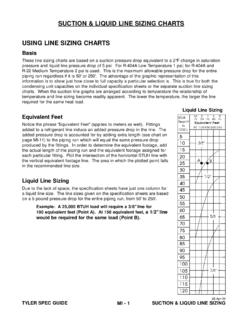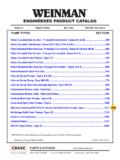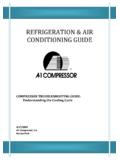Transcription of Practical Considerations in Pump Suction Arrangements
1 PDHonline Course M134 (3 PDH) Practical Considerations in PumpSuction Arrangements2012 Instructor: Randall W. Whitesides, PEPDH Online | PDH Center5272 Meadow Estates DriveFairfax, VA 22030-6658 Phone & Fax: Approved Continuing Education PDH Course M134 Practical Considerations in Pump Suction Arrangements 2003, 2008 Randall W. Whitesides, CPE, PE 1 Practical Considerations in Pump Suction Arrangements Copyright 2003, 2008 Randall W. Whitesides, Course Overview An important aspect of pump hydraulic system design is the Suction or inlet conditions. Disregard for proper allowances can result in vortices, cavitation, and loss of prime. pumps do not force liquids through inlet or Suction piping, but rather create lowered pressures at the Suction nozzle which in turn in-duces the fluid to enter.
2 Any design that impedes or lessens the efficient transport of this liquid will, of course, result in less liquid being handled. Any design that encourages the introduction of entrained gas or liquid voids will likewise result in a less efficient pumping operation. In addition to poor performance, truly bad designs can in some cases actually result in physical damage to the pump or its parts. The study of pump Suction system configuration can be broken down into two parts: (1) Suction piping and (2) Suction source. Critical consideration must be given to both in order to properly design an effi-cient system. Proper Suction piping design and installation Considerations consist of pipe and pipe fittings and their relationship, quantity, and relative location to the pump Suction nozzle. Suction source design factors include the geometry of the source and the relative location of the Suction entrance point(s) to suc-tion liquid surface, source enclosure boundaries, and other Suction entrance points.
3 This course deals with both parts and is applicable generally to all types of pumps , since every pump s successful operation and useful life can be so dependent on a properly designed and thought-out Suction arrangement . Course Introduction There are many factors that affect the operation of a pump. Important factors are total head, speed, liquid properties, and physical arrangement /system connection. Included in the category of arrangement and connection are the Suction conditions. Excessive Suction lift, shallow inlet submergence, or insufficient Net Positive Suction Head available (NPSHA), all spell serious trouble from vibration, cavitation, lowered capacity, and reduced efficiency. While the Engineer may not have large control over some of the inher-ent process factors, with planning and foresight many times the pump Suction conditions can be optimized in the design stage.
4 This course offers ideas and summarizes generally accepted guidelines of Practical consideration in pump Suction Arrangements . PDH Course M134 Practical Considerations in Pump Suction Arrangements 2003, 2008 Randall W. Whitesides, CPE, PE 2 Course Content Do pumps Suck? True of False? There appears to be a continual disagreement on this subject. Actually, some purists would contend that a true state of absolute Suction is impossible (except in the perfect vacuum of space) and that only varying degrees of flow-causing differential pressure exist. Rightly or wrongly, the term Suction is firmly planted in hydrology as is evidenced with its extensive use as an adjective in pump ter-minology, , Suction connection, Suction line, Suction lift, etc. pumps create a partial vacuum letting atmospheric (or positive source) pressure force liquid into a lower pressure area of the pump; this is the definition of suck.
5 What is important to know is the fact that any impedance to hydraulically balanced, unrestricted flow, induced by this Suction , will be problematic. In Order to Form a More Perfect Stability The single most important function of a pump Suction system is to supply an unencumbered, evenly dis-tributed flow to the pump. This is true regardless if the intake configuration is a single pipe, an open sump, or a river. Secondly, the pump Suction system should not promote the external introduction, or in-ternal creation, of compressible flow elements, , air, vapor, or gas. Improper design of the Suction piping or sump, or inadequate pipe support exterior to the pump, can cause hydraulic disturbances that manifest in chronic and eventual destructive random frequency vibrations. Interestingly enough, internal pump problems such as bearing failures, seal failures, excessive erosion, excessive corrosion, excessive noise, and excessive vibration can many times be rooted to sources outside the pump itself and in the connected piping.
6 Often times the trouble emanates from poor Suction condi-tions and piping practices that encourage unbalanced hydraulic flow. Promoting hydraulic stability is maintaining hydraulic balance on pump rotating elements. If at all possi-ble, the direct connection of any type of pipe fitting to the pump Suction nozzle should be avoided. Pipe fittings cause uneven flow patterns. In single end Suction pump types, unbalanced flow axial to the pump shaft causes unequal liquid introduction to the impeller eye. This results in unbalanced thrust which in-creases bearing wear, reduced bearing life, and premature seal failure. Direct connection of elbows should always be avoided. In double Suction pumps , if directly connected elbows can not be avoided, they should be installed such that the elbows are in a plane perpendicular to the pump shaft. Figure 1 on the following page is an illustration of a single end- Suction centrifugal pump piping arrangement typi-cally witnessed in industry, with fittings installed in close proximity to the Suction nozzle.
7 PDH Course M134 Practical Considerations in Pump Suction Arrangements 2003, 2008 Randall W. Whitesides, CPE, PE 3 Figure 1 Typical single end- Suction piping arrangement Beyond what would logically be surmised to be unbalanced flow attribut-able to the elbow, studies have determined that a secondary, rotating flow, is imparted in the fluid by elbows. This secondary rotating flow is superimposed and conveyed with the main momentum flow in the axial direction. In addition to an axial force in the x direction, ancillary forces are imparted to the surroundings in the y and z directions. This secondary flow, sometimes referred to as pre-rotational flow, is ultimately carried into the impeller imparting additional damaging turbulence and inefficient internal recirculation. Bottom line: Directly connected or closely placed elbows are detrimental to pump opera-tion because of multiple and compounding reasons.
8 The Ninety degree (90E) elbow is commercially produced in two styles: short radius and long radius. The short radius elbow s center line radius (A) is equal to the nominal pipe diameter (D). In the long radius elbow, A is equal to Obviously, the long radius 90 Eelbow is more sweeping and imparts less tur-bulence and unbalanced flow than that of the short radius; it should be used whenever Suction elbows are unavoidable. PDH Course M134 Practical Considerations in Pump Suction Arrangements 2003, 2008 Randall W. Whitesides, CPE, PE 4 Following the Straight and Narrow The ideal Suction pipe approach to the pump s impeller eye is straight pipe. Field experience has shown that the ideal minimum length of full-size straight pipe, devoid of any obstructions to flow, immediately upstream of the pump Suction connection, should be 10D.
9 The absolute minimum length of full-size straight pipe, devoid of any obstructions to flow, immediately upstream of the pump Suction connection, should be 5D. This is illustrated in Figure 2. Figure 2 The rule of 10D Taking It Smooth and Easy Pump inlet piping should be designed and installed to provide smooth and orderly flow to the pump. The pump Suction bell reduces the contraction entrance frictional losses by smoothing the flow by elimination of a sharp inlet edge. Entrance fluid frictional losses can be reduced by as much as 80% depending on the size of the rounding. The Suction bell also reduces the approaching mean fluid velocity; it has been shown that minimum submergence depth varies directly with fluid velocity as it relates to vortex formation. (More on vorticies in a moment). Liquids undergoing sudden or sharp changes in cross-sectional flow area have intensified differential pressure losses which reduce flow.
10 PDH Course M134 Practical Considerations in Pump Suction Arrangements 2003, 2008 Randall W. Whitesides, CPE, PE 5 Some Restrictions May Apply-Void Where Prohibited Check valves are installed on pump discharge lines to prevent liquid flow reversal with the succession of pumping. In a similar fashion, a foot valve is simply a form of check valve, usually in a vertical position, usually incorporating a strainer, installed in the pump Suction line (see Figure 3). The purpose of the foot valve is to preclude back-flow from the pump through the Suction line. They are used to promote a liquid filled Suction line that hopefully will allow the pump to maintain prime. Much like standard check valves, they are available in various styles and principles of operation. By necessity they create an obstruction to flow and, therefore, should not be employed unless is deemed absolutely necessary.
















